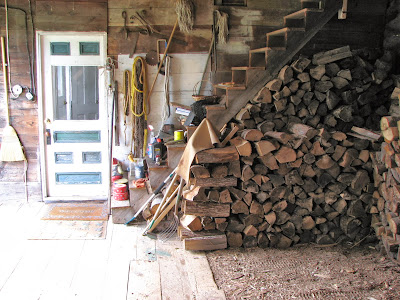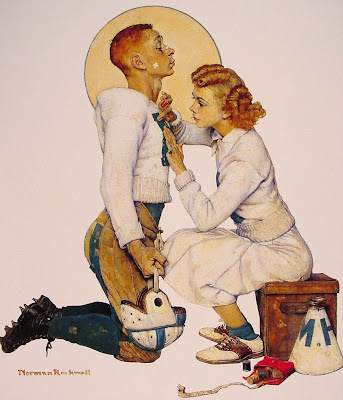Veterans Day has double meaning for me. On the one hand, I honor those who have served in the Armed Forces, (Can I get a big shout-out to all my Air Force Peeps!) but it's also the day that Norman Rockwell was buried in 1978.
There has been a slew of Norman Rockwell news lately. His painting
Saying Grace is on the
auction block. When he painted it in 1954 for the
Saturday Evening Post he got a few grand for it. Good money back then, mind you. This time around it's expected to get somewhere near the tens of
millions of dollars. It has been hanging in the Norman Rockwell Museum in Stockbridge, Massachusetts for several years. My hope is that whomever buys it is kind enough to let it hang there again, and not in some private room under lock and key. But if it
is under lock and key, and you the owner is reading
Maine-ly Painting, waddya say you let me come over and see it every once in awhile?
As a result of this new found re-fame, new attention is being paid to his life and work. People are beginning to re-appreciate the man and artist, but some of the old attacks have re-surfaced as well. And as a Rockwell fan, they drive me nuts.
You know, I have studied American History for over forty years. I have read hundreds of history books. When the best authors like David McCullough, Bruce Catton and Doris Kearns Goodwin write biographies, they put their subjects in the proper context of the world in which they lived. They understand that nothing happens in a vacuum; We are the products of the world around us. Those that do not understand that concept make the mistake of isolating their subject in time and applying today's sensibilities and morals to their actions. (ie; "It's unbelievable-- Abraham Lincoln walked miles to get to school! Just imagine!" What-- Everybody else took the bus?) That mistake is true of the way most critics still think of Rockwell.
Now, it goes without saying, (but I will) I'm a huge fan of Rockwell, but when some slob prattles on with the tiresome and ignorant
Norman Rockwell's Art is a saccharine, unrealistic view of the world bull, I think of one thing:
There is
no such thing as Norman Rockwell's
Art.
Now, I know that may come across as blasphemous, but hear me out; You can not judge the paintings of Norman Rockwell in the same context as an Andy Warhol, Jackson Pollack, Andrew Wyeth or any Fine Arts painter expressing his tastes and
free-will in paint!
Think about it-- It's not like Rockwell painted all those pictures, then looked around to see who might use them. Just about every painting he made was the result of someone else's vision. Advertising, illustration, calendars, magazine covers; all of them were paid assignments. Where are the paintings by Rockwell that were done for his own amusement? Unlike fellow illustrators like NC Wyeth or Harvey Dunn, he left behind no nudes, seascapes, landscapes. Nothing. He was not a Fine Artist trapped in the body of an Illustrator. He was first and last a commercial illustrator down to his core.
Quick bio note: Rockwell was born in 1894 in New York City to a typical middle class couple. When Norman was a child, his family would spend a few weeks each summer vacationing in upstate New York at small farms. But just like how an all-inclusive vacation at some resort in St Lucia gives you no idea of how life really is on an impoverished Caribbean island, Rockwell's time on the farm gave him a distorted, romantic view of country life. It worked to his advantage later, though. His early paintings, which were commissioned by children's magazines, were of kids living the idyllic life in the country. To paint them, he used his memories and imagination, because for almost all of the first half of his life, he lived in the suburbs of the city.
Illustrators got to be known for the type and style of their work. If a company wanted a slick, good looking man they might use J.C. Leyendecker. If a good looking girl was required they might commission Charles Dana Gibson or Coles Philips. When advertisers wanted Americana, they would lean to Norman.
Rockwell got to be so well known as a painter of country kids, that Coca Cola, Orange Crush and others used him for their advertising. Those companies were trying to appeal to the nostalgia of their customers, who by the 1920's had been born in the 1870's and 80's; Back before the devastation of WWI, and the avalanche of technology that had so altered the world of their youth. So all those paintings of folksy, innocent kids that are thought of as "Norman Rockwell's America" were really more the vision of Coca Cola and other advertisers.
The same goes for the calendars he painted. The Boy Scouts used him for 50 years. Every painting he did for them had to show a squeaky-clean boy in a perfect uniform. Rockwell could dream up the image, but the Boy Scouts had final approval. Of course, Rockwell was going to come up with a visual idea that would appeal to them. So for all those cute, perfectly handsome, All-American Cub and Boy Scouts, and those calendars of fetching, handsome couples engaged in dreamy, romantic- and unrealistic activities-- Oh! And let's not forget those overly sweet Christmas Cards-- Don't blame Norman. Blame the Boy Scouts, Hallmark and Brown and Bigelow Calendars. Biographers and critics who merely look at those paintings as his depiction of the world without understanding
why they were done look foolish trying to psychoanalyze them.
I guess the closest we can come to the concept of Norman Rockwell's Art would be the cover paintings he did for the
Saturday Evening Post. Those were not illustrations in that they were not visual depictions of the printed word, but told a story by themselves. Rockwell loved doing them because he had full control over the subject matter and his treatment of it. So in that aspect, can't we look at those paintings as his personal statement?
Well... Not entirely.
The Saturday Evening Post was an immensely popular magazine during the Twenties, Thirties, Forties and Fifties, with millions of copies being sold weekly. To be a cover artist was considered by illustrators to be the pinnacle of the trade. Rockwell grew to be the most popular of them all. But to be popular meant not offending
anyone. The Post had a very specific idea of how they wanted to portray the American middle-class. So the pressure was on all of their cover artists to conform to that ideal while trying to appeal to as wide an audience as possible. (And to see what would happen if the editors thought the artist wrong, check this
link out). Rockwell had to not only come up with ideas that he wanted to paint, but with a subject the Post would approve and middle-America audience would like. His years in the business had taught him what was expected of him. He did admit that he painted life not as it was, but how he wished it to be.
The Post used a formula for cover art. One week, Nostalgia, next week, Pretty Girl, week after that Home Life or Cute Kids. Check out the
Curtis Publishing site, they have a line up of some of the Post's cover artists. (It's a shame, though. They used to have every cover by year, but don't anymore). Look through some of those artists covers and you'll notice something. It's not like every other cover was a dark depiction of urban decay, and then here comes a sunny Norman Rockwell cover. All those wholesome genre scenes with cute kids and idyllic country life were being done by
everybody! They are not just a Norman Rockwell invention. Although if truth be told, it's the quality of his paintings that puts him head and shoulders above the rest, not the subject matter.
So having said all this, why is Norman Rockwell still so misunderstood some thirty-five years after his death? While his paintings are gaining more and more respectability in the art world, there is still the "Rockwell was a hack" school of thought out there. I think what confuses the art cognoscenti wasn't just his subject matter, but how he conveyed it. Rockwell was supremely adept at realism. (Artists understand what a great painter he truly was). His people aren't cartoons, but portraits. There is palpable sense of honesty in his people. His settings are true-to life and recognizable. The furniture was real. The clothes lived in. It all seems so
right. But you know what? Stephen King figured this out and employs it frequently. Stephen Spielberg understands the concept as well. But they got it from Rockwell:
Make the settings as authentic as possible, and the public will believe the fantasy being portrayed.
Norman Rockwell really wanted people to like his paintings, and through them, him. Make no mistake, he was justifiably proud of being considered "America's Favorite Artist." So he knew he had an image to uphold as a painter, and he didn't want to stray from that image. And it was a two way street: Advertisers wanted a wholesome "Rockwell Look" and he was glad to give it to them. In doing so he won the hearts of the public. You know- the folks who "Don't understand art" but know what they like.
Like I said before, those of us who admire Rockwell aren't concerned so much with
what he painted, or
why he painted it, but
how he painted it. And he was a genius as a painter.
Everything else we leave to psycho-babble critics.
.












+of+IMG_5904.jpg)















+of+mending-the-sail-1896%5B1%5D.jpg)






















